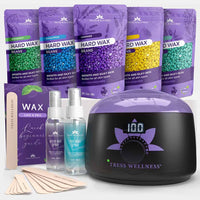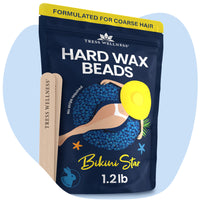What is ingrown hair?

After you have waxed your skin, the hair that was removed starts to grow back. Usually, this would penetrate the skin and grow naturally, but in some cases, it curves into the skin and grows back in the wrong direction. Although ingrown hair is more common when you shave using a razor, there is always a chance to get ingrowns after waxing. During waxing, if the hair is not uprooted right from the follicle, some amount of hair is left behind beneath the surface of the skin, causing the hair to grow beneath the skin’s surface.
Accumulation of dirt and dead skin cells over the skin can also lead to ingrown hair by stopping the growth of baby hair in the upward direction. Ingrown hair is most common in the underarm area or the bikini area since the hair growth in these regions is random, thick, and often curly. However, you might also get ingrown hair on your legs and arms after hair removal.
How does skin with ingrown hair look and feel?
Ingrown hair causes tiny bumps and rashes on the skin. Sometimes these will cause irritation, dryness, itchiness, and even pain. These bumps look like blisters and are filled with pus. Since these blisters are irritable, excessive touching and scratching can cause bacterial infection on the skin and scarring of the skin.
Here are a few signs that you can look for on your skin to confirm if you have ingrown hair after waxing:
- Red Bumps: Ingrown hair often appears as small, red bumps on the skin. These bumps may be slightly raised and can resemble pimples.
- Itching and Discomfort: Ingrown hair can be itchy and uncomfortable. You might feel a constant irritation or a tingling sensation around the affected area.
- Inflammation: The surrounding skin of an ingrown hair may become inflamed, causing redness and swelling. This inflammation is the skin's response to the trapped hair.
- Pain or Tenderness: Ingrown hair can be tender to the touch and may cause mild to moderate pain. This discomfort is often localized around the site of the ingrown hair.
- Visible Hair Under the Skin: Sometimes, you can see the trapped hair just beneath the surface of the skin. It may appear as a dark or coiled strand beneath the red bump.
- Pus or Whiteheads: In more severe cases, ingrown hair can develop into pustules or whiteheads. These are often a result of infection and can be accompanied by pus.
- Dark Spots or Hyperpigmentation: After the ingrown hair resolves, it may leave behind a dark spot or hyperpigmentation on the skin. This is especially common in individuals with darker skin tones.
- Strawberry skin: You may have seen tiny dark spots over a larger area on your legs. This is commonly known as strawberry skin. This can occur due to ingrown hair after shaving or waxing.
Ingrowns after Waxing? No More: Top Tips to Beat Ingrown Hair
The first step to preventing ingrown hair is to follow a good skincare routine and take care of your skin. If you have specific skin concerns that need an expert opinion, we advise that you visit a dermatologist.
If everything feels fine, this is how you beat the ingrown hair at its root.
Tip 1: Choose Hard Wax
In the battle of the better wax type, hard wax takes the crown. Hard wax settles better on your skin and sticks better to the hair strands. As a result, when you pull out hard wax, the chances of pulling out your hair right from the follicle are much higher. Soft wax or sugar wax often doesn’t stick properly to hair strands causing hair breakage at the surface, which is somewhat similar to removing hair using razors. Hence, the risk of getting ingrowns after waxing is a lot higher with soft wax, almost as much as with shaving.

Tress Wellness’s hard wax beads are designed especially for salon finish waxing at home. It is convenient, reusable, and more effective in preventing ingrown hair.
Tip 2: Exfoliate Gently and Regularly

Exfoliating your skin regularly improves overall skin health, and is great for removing dirt and dead skin cells. You can exfoliate your skin once or twice a week, and it helps a great deal in preventing pores from getting clogged and trapping baby hair beneath the skin's surface. Some areas of your skin are gentler than others and using granular body scrubs can irritate the skin further. For such concerns, you can opt for salicylic acid-based cleansers for gently breaking down dead skin build-up, while also not irritating your skin further. Try exfoliating your skin a day or two before waxing. This makes sure that you have a clean canvas to work with on your day of waxing and prevents ingrown hair after waxing.
Tip 3: Hydration Goes a Long Way
Keep your good, old moisturizers handy because their benefits are plentiful! Healthy and nourished skin does not dry out and flake, and aids in healthy hair growth. Dry and flaky skin can not only cause ingrown hair but also worsen the effects of ingrown hair after waxing. Use cream-based or oil-based moisturizers depending on your skin type daily, except before your waxing session.
- Salicylic Acid: Salicylic acid is widely used in skincare for its ability to exfoliate the skin and unclog pores, which can help prevent ingrown hairs. While research on its specific role in ingrown hair prevention is limited, it is a commonly recommended ingredient by dermatologists for this purpose.
- Glycolic Acid: Glycolic acid, like salicylic acid, is an exfoliant that can help remove dead skin cells and improve skin texture, potentially reducing the risk of ingrown hairs.
- Tea Tree Oil: Tea tree oil is known for its antibacterial and anti-inflammatory properties. It can help reduce the risk of infection and soothe irritated skin after hair removal, which can indirectly help prevent ingrown hairs.
Tip 4: Proper Post-Waxing Care
Your skin requires great care regardless of what method of hair removal you use. There are a few things you should keep in mind if you are waxing to get rid of body hair. You need to prep your skin properly before applying wax to it. Tress Wellness’s pre-waxing spray prepares your skin for the process. It does not dry out your skin excessively or clog your pores, but at the same time helps the wax to set on your skin for the perfect waxing experience.
Post-waxing, your skin is usually sensitive, and taking good care of it post-waxing is a must! Our post-wax spray calms your skin down after waxing and imparts hydration to it. In addition, do not forget to use a moisturizer after the application of the post-wax spray to seal in all the goodness of the spray.
Proper prep and aftercare make the waxing experience smooth and bump-free and prevent ingrowns after waxing.
Tip 5: Avoid Tight Clothing after Waxing
Wearing tight clothes right after getting that silky-smooth wax can be a real downer. But did you know it can also lead to those pesky ingrown hair? Here's the scoop on how snug outfits can mess with your post-waxing glow.
So, when you squeeze into your favorite skinny jeans or rock those tight leggings immediately after a wax, you're basically giving your skin a hard time. The friction caused by snug clothing can irritate your freshly waxed skin. This irritation can make it tough for your newly waxed hair to grow out naturally. Sometimes, it can even cause the hair to break or curl back under your skin. Ouch! That trapped hair then becomes the perfect recipe for ingrown hair after waxing.
What's worse, tight clothes can trap heat and moisture against your skin. This added warmth and moisture can increase skin irritation and the risk of infection, making ingrown hair more likely to rear its ugly head.
To avoid this hairy situation, opt for loose, comfy clothing right after waxing. Let your skin breathe, reduce friction, and give your hair the space it needs to grow out naturally.
There you have it! Your own little skin routine to prevent ingrown hair from coming between you and your silky, smooth skin dreams. These are your best tips for preventing ingrown hair post-waxing.
Comment below if you have tried any of these. Share this blog with your friends to save them from ingrown hair!
Happy waxing!




